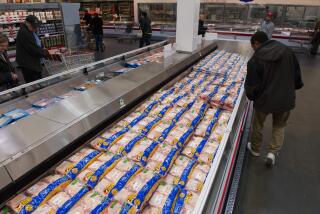This Is No Chicken Joke : The USDA’s definition of ‘fresh’ should be overhauled immediately
- Share via
Federal rules requiring truth in labeling processed foods as “low sodium” or “light” are, at long last, going into effect. Given this welcome--and long-overdue--development on an issue of public health and safety, it is odd that the U.S. Department of Agriculture still defines a “fresh” chicken as one that has been stored at temperatures of zero degrees Fahrenheit or higher. Because poultry freezes at 26 degrees, many chickens labeled as fresh in supermarkets actually froze while being transported and then thawed.
House subcommittee hearings on the matter this week occasioned testimony from celebrity chef Wolfgang Puck and a “bowling demonstration” using a chicken--one defined as fresh but in fact frozen as hard as any ball that ever toppled tenpins.
Beneath the chicken humor there is a serious subject for California’s poultry industry, one of the biggest in the nation, and for the consumers of poultry. Because chicken feed and packinghouse labor costs more in California than in other major poultry states, California producers prefer selling their product fresh to a regional market rather than incurring added costs in shipping it throughout the country. Indeed, the industry claims that 98% of California chickens are sold fresh, having never been frozen.
Fresh chickens command a higher price, 50 cents per pound more on average. But so do chickens produced elsewhere that, when they reach California markets, have been frozen but are legally defined as fresh under USDA rules. Those rules need to change. They fly in the face of common sense and come close to consumer fraud.
Last year the California Legislature passed a law to prevent such mislabeling but a federal court struck it down, ruling that it conflicted with federal law. That’s why the USDA needs to act--and soon.
More to Read
Eat your way across L.A.
Get our weekly Tasting Notes newsletter for reviews, news and more.
You may occasionally receive promotional content from the Los Angeles Times.








